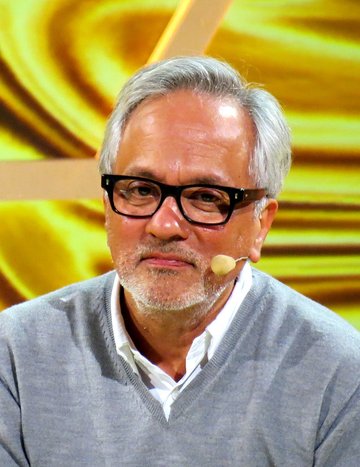
Anish Kapoor
Mumbai-born artist who has produced internationally renowned sculptures
Place of birth
Date of arrival to Britain
About
Anish Kapoor was born in 1954 in Mumbai to parents of Iraqi Jewish descent (his mother) and Indian descent (Hindu Punjabi, his father). His father was a hydrographer, and there were no artistic influences in his own family which he derived inspiration from. Rather, it was after he briefly studied electrical engineering in Israel that he decided to pursue art instead. Indeed, he has cited artists Donald Judd and Joseph Beuys as key drivers, as well as Paul Neagu, a Romanian-born sculptor who taught Kapoor in London during the 1970s. He studied for his undergraduate degree at Hornsey College of Art between 1973 and 1977 and his master's at Chelsea School of Art between 1977 and 1978. Carving out a career after his art training was difficult for Kapoor, so he spent time making furniture for the interior designer Nicky Haslam. He also taught at Wolverhampton Polytechnic for a short time.
Kapoor has gained global acclaim because many of his sculptural works are not simply artistic endeavours but huge feats of engineering. They dominate public arenas such as galleries and open-air environments, and spectators are invited to occupy those spaces alongside them. He gained early recognition in 1978 with a group exhibition in London, and then his first solo exhibition was in Paris in 1980. Kapoor’s frequent visits to India and his association with the New British Sculpture movement lend his style a sense of cultural, material and technological fusion and experimentation. The late 1990s and early 2000s were a particularly lively period for Kapoor. For example, his large commanding red installations Taratantara (1999) and Marsyas (2002) were the forerunners to his future open-air steel structure in Middlesbrough which hangs across the side of the River Tees, called Temenos (2009). In the intervening time between these projects he completed his most famous piece in Millennium Park in Chicago, called Cloud Gate. Between September and December 2009 his solo exhibition at the Royal Academy, including works such as Shooting into the Corner and Tall Tree and the Eye, drew in crowds in Mayfair, London of around 275,000 people.
Kapoor’s work was also pivotal to the image of the 2012 Olympics hosted in London. He designed the ArcelorMittal Orbit, an observation tower made of recycled materials which visitors can ascend for views of the city. At 114.5 metres tall, Orbit is the UK’s tallest sculpture. The Sri Lankan architect Cecil Balmond helped to design Orbit and the Indian billionaire chair of the steel-making company ArcelorMittal, Lakshmi Mittal, provided the steel to make Kapoor’s vision a reality. After the success of Orbit, Kapoor made the Queen’s birthday honours in 2013 and was awarded a knighthood for his services to visual arts. Kapoor has been highly decorated with other awards throughout his career, including the Turner Prize in 1991 and honorary fellowships at universities such as Leeds University (1997). He was also elected a member of the Royal Academy in 1999.
Kapoor has two children with his first wife, Susanne Spicale, an art historian, and one child with his second wife, Sophie Walker.
Paris Biennale, 1982
Venice Biennale, 1990
Brighton Festival, 2009
London Olympics, 2012
‘Anish Kapoor: In Conversation with Greg Hilty and Andrea Rose’, Anish Kapoor website, https://anishkapoor.com/191/in-conversation-with-greg-hilty-and-andrea-rose
Anthony, Andrew, ‘Anish Kapoor: Superstar Sculptor Who Loves to Court Scandal’, Guardian (7 June 2015)
Dodgson, Neil A., ‘Engineering Art and Telling Tales: Anish Kapoor at the Royal Academy’, Interdisciplinary Science Reviews 41.4 (2016), pp. 281–96
Higgins, Charlotte, ‘Anish Kapoor: "I think we've gone totally public-sculpture mad. I hate public sculpture ... Oh God, even the phrase makes me feel tired"’, Guardian (8 November 2008)
‘Kapoor, Anish’, Grove Art Online (Oxford University Press, 2003), https://www.oxfordartonline.com/groveart/view/10.1093/gao/9781884446054.001.0001/oao-9781884446054-e-7000045799
Windsor, Alan (ed.) British Sculptors of the Twentieth Century (Aldershot: Ashgate, 2017)
Wise, Louis, ‘Anish Kapoor’s “mad, mad project”’, Financial Times (25 February 2022)
CABE 5/437, The London 2012 Olympic and Paralympic Games Design Review Panel: London 2012, National Archives, Kew, UK
BS/5/1/553, Kapoor: Anish, 1998-2009, Paul Mellon Centre for Studies in British Art, London
BS/5/1/72, Arts Council: Pertinax CXLVIII, 1999, Paul Mellon Centre for Studies in British Art, London
TG 106/300, Anish Kapoor: Drawings, 1990, Tate Gallery Archive, London
TGA 200414/2/1/36, Notepad titled 'Venice Biennale 90', 1990, Tate Gallery Archive, London
TG 4/9/568/11, New York: Museum of Modern Art (MoMA), Loan of works, February 1984 to April 1987, Tate Gallery Archive, London
TGA 200414/2/181, Working file titled 'Photographs/Transparencies Magazine & Supplements & Unpublished Recordings', n.d., Tate Gallery Archive, London
TGA 200414/5/1/25, Exhibition catalogues, 1999, Tate Gallery Archive, London
Image credit
Anish Kapoor, interviewed about his new virtual reality artwork at the Nobel Week Dialogue in 2017, 9 December 2017, Vogler, CC BY-SA 4.0, via Wikimedia Commons
https://creativecommons.org/licenses/by-sa/4.0/
Entry credit
Ellen Smith
